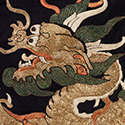|
|
| Show All 110 Results (Text Only) |
|
| Amazing Tangka Stories |
|
| American Museum of Natural History
|
An Interactive website presenting two sets of Tibetan tangkas: Jataka Tales (past life stories of the Buddha) and Dipankara Atisha (famous Indian Buddhist monk). The tangkas are shown with their original Tibetan inscriptions and English translation(viewers can click on sections of each painting and see the story)The paintings that depict stories (avadanas) of exemplary people as told by the Buddha who fulfill the Buddhist ideal of the Bodhisattva, a person who always gives whatever he or she can to help others. Through such generosity, over many lifetimes, they will become enlightened. The Buddha tells each story and at its end he identifies the main characters in their present life, that is, as his own contemporaries. In some cases these are past life stories (jatakas) of the Buddha.
Go to Museum Resource: https://anthro.amnh.org/tangka_stories | |
|
|
| Ancient Vietnam: Ports of Call |
|
| Asia Society
|
A video showing the objects in “Arts of Ancient Viet Nam: From River Plain to Open Sea,” narrated by the curator. "This exhibition brings together more than one hundred objects from ten museums across the diverse geographic expanse that is Viet Nam to illuminate the country’s long history of cultural and economic exchange... As long as two thousand years ago, a maritime trade route extended from southern China to Roman-controlled ports in the Persian Gulf and Red Sea, via ports in what is now northern Vietnam, Southeast Asia, Sri Lanka, India, Pakistan and Iran. As a result of this exchange, Vietnam developed unique art objects with connections to China, India, and other cultures of Southeast Asia… The exhibition focuses on four areas and ports of call: 1) Early Cultures: Dong Son and Sa Huynh; 2) Fu Nan in the Mekong River Delta; 3) Coastal Kingdoms of Champa; 4) Trade and Exchange in Hoi An.” This was a trade in luxury goods, where merchants had to follow the monsoon winds sailing east and west. See also: Arts of Ancient Viet Nam: From River Plain to Open Sea
Go to Museum Resource: https://asiasociety.org/video/ancient-viet-nam-ports-call-complete | |
|
|
| The Artful Fabric of Collecting |
|
| Jordan Schnitzner Museum of Art, University of Oregon
|
Chinese textiles from the collection of Gertrude Bass Warner (1863-1951), who… was particularly drawn to silk textiles and the people who produced them, primarily the women in private households and commercial workshops. Techniques and patterns of weaving silk for Chinese robes are demonstrated on the site. It was only in the 17th century when the production of court orders began to overwhelm the imperial workshops that commercial workshops took over some of the production. In these commercial workshops, most of them located in the Jiangnan area, the center of China’s silk production, male weavers relegated women to the groundworks of silk production: the rearing of the silkworms and reeling the silk of the cocoons. Embroidery remained the domain of women. They were the master embroiderers who developed the art to its height in the Qing Dynasty (1644-1911). Their legacy can be admired in the textiles from the Warner collection.
Go to Museum Resource: https://glam.uoregon.edu/s/fabric-of-collecting/page/welcome | |
|
|
| Art of the Samurai: Japanese Arms and Armor, 1156–1868 |
|
| The Metropolitan Museum of Art
|
Online presentation of a 2009-2010 exhibition, the "first comprehensive exhibition devoted to the arts of the samurai" and "the first exhibition ever devoted to the subject of Japanese arms and armor conservation." With images of 27 objects.
Go to Museum Resource: https://www.metmuseum.org/exhibitions/listings/2009/art-of-the-samurai/photo-ga... | |
|
|
| Art of the Silk Road |
|
| University of Washington
|
Online exhibit "organized as part of Silk Road Seattle, a collaborative public education project exploring cultural interaction across Eurasia from the first century BCE to the sixteenth century CE." With text and images organized into four categories: 1) Cultures (with a timeline from 400 BCE to 1600 CE); 2) Religions (Buddhism, Zoroastrianism, Nestorianismism, Islam, Manichaeism); 3) Trade (text about trade routes, horses and camels, silk); 4) Intercultural Exchange.
Go to Museum Resource: http://depts.washington.edu/silkroad/exhibit/index.shtml | |
|
|
|
| The Arts of Thailand |
|
| Victoria and Albert Museum
|
An introduction to the V&A's new Arts of Thailand exhibit, which "features the museum's finest Thai Buddhist sculptures in bronze and stone spanning the period from the 7th to the 19th centuries, together with works of decorative art in a wide variety of media associated both with the Thai court and with monasteries." Thirty-eight objects are featured online; all objects have descriptions.
Go to Museum Resource: http://www.vam.ac.uk/content/articles/t/the-arts-of-thailand/ | |
|
|
| Arts of the Samurai [PDF] |
|
| Asian Art Museum of San Francisco
|
"The term samurai is derived from the word saburau, or “one who serves.” The evolution of the samurai from mounted guards to the nobility (during the twelfth century) and their subsequent ascent to military leaders of Japan (until imperial restoration during the nineteenth century) is chronicled in distinctive warrior arts and literary tradition. This packet examines the samurai through precious art objects from the museum’s collection. These include authentic military equipment (arms and armor), paintings depicting famed conflicts, ceremonial attire, and objects created for religious and cultural pursuits strongly connected with the samurai class."
Go to Museum Resource: https://education.asianart.org/wp-content/uploads/sites/6/2019/12/ArtsofSamurai... | |
|
|
|
| Show All 110 Results (Text Only) |









